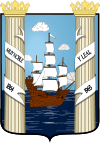Maracaibo
| Maracaibo | |||
|---|---|---|---|
| Municipality | |||
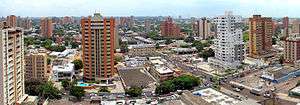     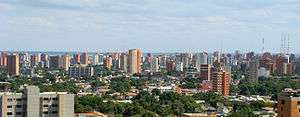 .jpg) Images of Maracaibo | |||
| |||
|
Nickname(s): "La Tierra del Sol Amada" (English: "The Beloved Land of the Sun") | |||
|
Motto(s): "Muy noble y leal" (English: "Very noble and loyal") | |||
.svg.png) Maracaibo | |||
| Coordinates: 10°39′N 71°38′W / 10.650°N 71.633°WCoordinates: 10°39′N 71°38′W / 10.650°N 71.633°W | |||
| Country |
| ||
| State | Zulia | ||
| Municipality | Maracaibo | ||
| Founded | (1) 8 September 1529, (2) 1569, (3) 1574 | ||
| Founded by | Ambrosio Alfínger (1529), Captain Alonso Pacheco (1569), Captain Pedro Maldonado (1574) | ||
| Government | |||
| • Type | Mayor-council | ||
| • Body | Alcaldía de Maracaibo | ||
| • Mayor | Evelyn Trejo de Rosales (UNT) | ||
| Area | |||
| • Metro | 1,393 km2 (538 sq mi) | ||
| Elevation | 6 m (20 ft) | ||
| Population (2013) | |||
| • Rank | 2nd | ||
| • Urban[1] | 2,658,355 | ||
| • Metro[2] | 3,897,655 | ||
| Demonym(s) | Marabino(a), Maracaibero(a), Maracucho(a) | ||
| Time zone | UTC-04:30 (VST) | ||
| • Summer (DST) | UTC-04:30 (not observed) | ||
| Postal coded | 4001, 4002, 4003, 4004, 4005 | ||
| Area code | 261 | ||
| ISO 3166 code | VE-V | ||
| Website | Alcaldía de Maracaibo (in Spanish) | ||
| The area and population figures are for the municipality. | |||
Maracaibo (/ˌmærəˈkaɪboʊ/; Spanish pronunciation: [maɾaˈkaiβo]) is a city and the municipal seat of Maracaibo Municipality in northwestern Venezuela, on the western shore of the strait that connects Lake Maracaibo to the Gulf of Venezuela. It is the second-largest city in the country (after the national capital Caracas) and the capital of the state of Zulia. The population of the city is approximately 1,495,200[1] with the metropolitan area estimated at 2,108,404 as of 2010.[2] Maracaibo is nicknamed La Tierra del Sol Amada ("The Beloved Land of the Sun").
Etymology
The name Maracaibo is said to come from the brave cacique (Indian chief) Mara, a young native who valiantly resisted the Spaniards and died fighting them. Legend says that when Mara fell, the Indians shouted "Mara kayó!" (Mara fell!), thus originating the city name --although it would be strange for them to shout in Spanish. Other historians say that the first name of this land in the local language was "Maara-iwo" meaning "Place where serpents abound".
History
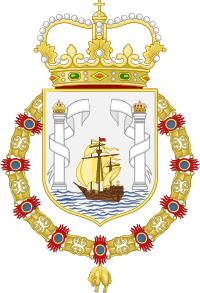
Foundation
The first indigenous settlements were of Arawak and Carib origin. Around the main group were the Añu tribe who built rows of stilt houses all over the northern riviera of the Lake Maracaibo.[3] The first Europeans arrived in 1499.
The city was founded three times: the first time was during the Klein-Venedig period (1528–1546), when the Welser bankers of Augsburg received a concession over Venezuela Province from Charles I. of Spain. In August 1529, the German Ambrosius Ehinger made his first expedition to Lake Maracaibo, which was bitterly opposed by the indigenous Coquivacoa. After winning a series of bloody battles, he founded the settlement on 8 September 1529. Ehinger named the settlement New Nuremberg (German: Neu-Nürnberg) and the lake after the valiant chieftain Mara of the Coquivacoa, who had died in the fighting. The city was renamed Maracaibo after the Spanish took possession.[4] The lack of activity in the zone made Nikolaus Federmann evacuate the village in 1535 and move its population to Santa Marta near the then capital of Venezuela Province, Santa Ana de Coro.
A second attempt by Captain Alonso Pacheco in 1569 suffered a brief setback when the city had to be evacuated in 1573 due to ferocious attacks by native local tribes. The European settlement returned a short while later, in 1574, however, for which it was re-founded by Captain Pedro Maldonado under Governor Diego de Mazariegos' command and assuming the name of Nueva Zamora de Maracaibo. "Nueva Zamora" comes from Mazariego's place of birth, Zamora, in Spain. Since its definite foundation, the town began to develop as a whole. It is based on the western side of Lake Maracaibo, the dominant feature of the oil-rich Maracaibo Basin. Favoured by prevailing winds and a protected harbour, the city is located on the shores of the lake where the narrows, which eventually lead to the Gulf of Venezuela, first become pronounced.
Pirates' attacks
The Dutch corsair Enrique de Gerard plundered Maracaibo in 1614, and in 1642 the city was attacked by the British pirate William Jackson. In 1667, l'Olonnais with a fleet of eight ships and a crew of six hundred pirates sacked Maracaibo and Gibraltar. En route, l'Olonnais crossed paths with a Spanish treasure ship, which he captured, along with its rich cargo of cacao, gemstones and more than 260,000 pieces of eight.
In March 1669, Henry Morgan sacked Maracaibo, which emptied when his fleet was first spied, and moved on to the Spanish settlement of Gibraltar on the inside of Lake Maracaibo in search of more treasure. A few weeks later, when he attempted to sail out of the lake, Morgan found an occupied fort blocking the inlet to the Caribbean, along with three Spanish ships. These were the Magdalena, the San Luis, and the Soledad. He destroyed the Magdalena and burned the San Luis by sending a dummy ship full of gunpowder to explode near them, after which the crew of the Soledad surrendered. By faking a landward attack on the fort, thereby convincing the Spanish governor to shift his cannon, he eluded their guns and escaped.[5][6]
In June 1678, Michel de Grammont French commander of six ships and 700 men captured Maracaibo then followed the plundering of several smaller towns as Gibraltar, penetrating as far inland as Trujillo.
Venezuelan independence
In 1810, the province of Maracaibo did not join the First Republic of Venezuela and remained loyal to the Spanish crown. Maracaibo then held the seat of the Captaincy General of Venezuela.
In 1821, uprisings in favour of independence began to lead to warfare and hostility. The royalists, led by Francisco Tomás Morales, fought with the patriots, led by Rafael Urdaneta, to take back control over the province in the Juana de Ávila Battle and Morales brought back Spanish rule in 1822 until he was defeated at the Battle of Lake Maracaibo on 24 July 1823, culminating Venezuela's struggle for independence.
Isolation period
For about 390 years, Maracaibo remained isolated and separated from the rest of the country. Transportation was only possible across the lake by ferry or other marine transport.
Cars, buses, and lorries, with their constant flow of manufactured goods and agricultural product, depended on the ferry system between the city and the eastern shore with their roads to connect to the country's motorway system. Maracaibo and the Lake Maracaibo region's economy was more linked to Colombia than to eastern Venezuela due to the natural route available through Lake Maracaibo then leading to the sea.
This isolation was both a challenge and an advantage. The very nature of the city's location made for a population known for their independent thought and character. The history of this region is rife with stories about the creation of an independent and sovereign nation apart from Venezuela, a nation called La República Independiente del Zulia, which means The Independent Republic of Zulia, but this has never come to be.
In January 1903, as the naval blockade of Venezuela continued during the negotiations with presidente Cipriano Castro, the German warship SMS Panther attempted to enter Lake Maracaibo, which was a centre of German commercial activity. On 17 January, it exchanged fire with the settlement of Fort San Carlos, but withdrew after half an hour, as shallow waters prevented it getting close enough to the fort to be effective. The Venezuelans claimed this as a victory, and in response the German commander sent the SMS Vineta, with heavier weapons, to set an example. On 21 January, the SMS Vineta bombarded the fort, setting fire to it and destroying it, with the death of 25 civilians in the nearby town.
In 1908, the Friesland, Gelderland and Jacob van Heemskerck were sent to patrol the Venezuelan coast during the second Castro crisis. Friesland guarded the entry way to Maracaibo.[7]
Building of the bridge
The dictatorial regime of General Marcos Pérez Jiménez in the 1950s set as a goal the construction of a bridge connecting the two lake shores. Various bridge projects for the spanning of the Lake Maracaibo narrows near the city were in the works. The general's government had decided that this "city of independent thought" should be more "connected" to the rest of the country.
Proposals for a bridge design that included rail transport and tourist facilities were seriously considered. The fall of the Pérez Jiménez government on 23 January 1958, quickly led to a less elaborate design project that was approved and funded by a democratic and more conservative government.
The building of "El Puente Sobre El Lago de Maracaibo "General Rafael Urdaneta"—(General Rafael Urdaneta Bridge over Lake Maracaibo) named after the distinguished General hero of the War of Independence was opened to public traffic in 1962. The project was completed on schedule in 40 months.
This bridge construction project was a remarkable feat. Built under very difficult conditions, when completed, it became the longest prestressed concrete bridge in the world. The structure is in constant use and remains today as the most important link between Maracaibo, along with much of the state of Zulia, and the rest of Venezuela.

Modern times
Maracaibo has become a large metropolitan city, comprising two municipalities: to the north the municipality of Maracaibo and to the south the San Francisco municipality (established in 1995). In recent years, due to political/economic and cultural reasons, many have moved to Maracaibo from rural areas and other cities (including Caracas).
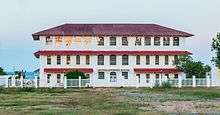
In the political arena, the citizens of Maracaibo (and most other cities and municipalities in Zulia state) have in recent years voted for a competitive political system in where the governor is from a certain political party and the mayor or mayors are from the opposite political party.
Maracaibo also boasts one of the best universities in the country, the state university. La Universidad del Zulia (LUZ) is well renowned for its excellent law, medical and engineering schools as many other disciplines. Other universities and schools include Universidad Dr. Rafael Belloso Chacín (URBE) and Universidad Rafael Urdaneta, with one of the country's leading psychology schools.
The Diocese of Maracaibo (23 July 1965) was elevated to Archdiocese on 30 April 1966 by Pope Paulus VI.[8] Maracaibo was visited by Pope John Paul II in 1985.[9][10] Since November 2000, its Archbishop has been Ubaldo Ramón Santana Sequera.

Perspective
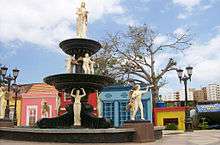
François de Pons, an agent to the French government in Caracas, provides some historical insight into the people of Maracaibo in his travel journal (de Pons 1806). The following excerpts describe the local population of Maracaibo:
- They perform coasting, or long voyages, with equal facility; and when all trade is suspended by the operations of war, they enter privateers. Bred up in the neighbourhood of the lake, they are mostly all expert swimmers and excellent divers. Their reputation stands equally high as soldiers. Those who do not enter into the sea service, form plantations, or assist in cultivating those that belong to their fathers. Nothing proves better their aptitude for this kind of occupation, than the immense flocks of cattle with which the savannas of Maracaybo [sic] are covered.
He also notes the appreciation of literature, the arts, education, and culture among the people of Maracaibo:
- But what confers the greatest honour on the inhabitants of Maracaibo, is their application to literature; in which, notwithstanding the wretched state of public education, they make considerable progress....They likewise acquired the art of elocution, and of writing their mother tongue with the greatest purity; in a word, they possessed all the qualities that characterise men of letters.
Economy
Zulia´s main income comes from oil extraction and refining, agriculture (coffee, rice, maize, cassava, cocoa, sugar cane), livestock production, and mining (clay, limestone, coal and sand).
Medicine
Huntington's disease prevalence worldwide is 5–10 cases per 100,000 persons. One of the highest incidences is in the isolated populations of the Lake Maracaibo region of Venezuela, where HD affects up to 700 per 100,000 persons.[11]
Geography
Location
The Maracaibo Municipality is currently divided into 18 parishes, which are
 Idelfonso Vásquez
Venancio Pulgar
Antonio Borjas Romero
San Isidro
Francisco Eugenio
Bustamante Luis Hurtado
Higuera Manuel
Dagnino Cristo
de Aranza Cacique
Mara Caracciolo
Parra Pérez Juana
de Ávila Olegario
Villalobos Santa
Lucía |
|
Climate
Maracaibo is one of the hottest cities of Venezuela. The rain shadow of the Sierra Nevada de Santa Marta gives the city a semiarid climate (Köppen: BSh) attenuated only by the moderating influence of the lake; Maracaibo’s average historical temperature is 29 °C (84.2 °F). In the past, the climate of the city, indeed all along the coast of Lake Maracaibo, was unhealthy due to the combination of high temperatures with high humidity. At the present time, control of plagues, and the effects of urban development, has largely eradicated these health problems. The registered high temperature of the city is 41 °C (105.8 °F), and the lowest is 18 °C (64.4 °F).
| Climate data for Maracaibo (1970–1998) | |||||||||||||
|---|---|---|---|---|---|---|---|---|---|---|---|---|---|
| Month | Jan | Feb | Mar | Apr | May | Jun | Jul | Aug | Sep | Oct | Nov | Dec | Year |
| Record high °C (°F) | 36.4 (97.5) |
39.4 (102.9) |
37.9 (100.2) |
39.6 (103.3) |
37.8 (100) |
38.0 (100.4) |
38.8 (101.8) |
38.1 (100.6) |
39.0 (102.2) |
36.6 (97.9) |
36.3 (97.3) |
35.8 (96.4) |
39.6 (103.3) |
| Average high °C (°F) | 32.5 (90.5) |
32.8 (91) |
33.1 (91.6) |
33.1 (91.6) |
33.1 (91.6) |
33.6 (92.5) |
34.1 (93.4) |
34.2 (93.6) |
33.6 (92.5) |
32.5 (90.5) |
32.4 (90.3) |
32.5 (90.5) |
33.1 (91.6) |
| Daily mean °C (°F) | 27.7 (81.9) |
28.0 (82.4) |
28.6 (83.5) |
29.0 (84.2) |
29.1 (84.4) |
29.3 (84.7) |
29.5 (85.1) |
29.6 (85.3) |
29.1 (84.4) |
28.3 (82.9) |
28.3 (82.9) |
27.9 (82.2) |
28.7 (83.7) |
| Average low °C (°F) | 22.8 (73) |
23.2 (73.8) |
24.1 (75.4) |
24.8 (76.6) |
25.0 (77) |
24.9 (76.8) |
24.9 (76.8) |
24.9 (76.8) |
24.6 (76.3) |
24.1 (75.4) |
24.1 (75.4) |
23.3 (73.9) |
24.2 (75.6) |
| Record low °C (°F) | 19.2 (66.6) |
18.8 (65.8) |
20.4 (68.7) |
20.7 (69.3) |
20.5 (68.9) |
20.2 (68.4) |
21.0 (69.8) |
20.2 (68.4) |
20.2 (68.4) |
20.0 (68) |
20.6 (69.1) |
18.9 (66) |
18.8 (65.8) |
| Average rainfall mm (inches) | 5.1 (0.201) |
2.7 (0.106) |
5.9 (0.232) |
52.1 (2.051) |
66.8 (2.63) |
55.4 (2.181) |
26.5 (1.043) |
60.0 (2.362) |
104.0 (4.094) |
114.4 (4.504) |
70.6 (2.78) |
16.9 (0.665) |
580.4 (22.85) |
| Average rainy days (≥ 1.0 mm) | 0.6 | 0.3 | 0.6 | 3.6 | 6.1 | 6.7 | 3.6 | 5.8 | 8.1 | 9.2 | 5.3 | 1.7 | 51.6 |
| Average relative humidity (%) | 69.0 | 68.5 | 68.0 | 71.5 | 73.5 | 71.0 | 69.0 | 69.5 | 72.0 | 75.0 | 73.0 | 72.0 | 71.0 |
| Mean monthly sunshine hours | 266.6 | 240.8 | 244.9 | 183.0 | 179.8 | 201.0 | 244.9 | 232.5 | 192.0 | 182.9 | 204.0 | 238.7 | 2,611.1 |
| Source #1: Instituto Nacional de Meteorología e Hidrología (INAMEH)[12][13] | |||||||||||||
| Source #2: NOAA (extremes and sun 1961–1990),[14] World Meteorological Organization (precipitation, 1961–1990)[15] | |||||||||||||
Education
Colleges and universities
Several universities are based in the city:
- Universidad del Zulia - (LUZ)
- Universidad Nacional Experimental de la Fuerza Armada UNEFA
- Universidad Rafael Belloso Chacín - (URBE)
- Universidad Rafael Urdaneta
- Universidad Católica Cecilio Acosta
- Universidad Dr. José Gregorio Hernández
- Universidad Bolivariano de Venezuela sede Zulia
- Universidad Nacional Abierta (UNA) Centro Local Zulia
International schools
- Escuela Bella Vista (American school)
- Colegio Alemán de Maracaibo, formerly Colegio Aleman del Zulia (German school)
Sports
Due to the regionalistic nature of Marabinos, they strongly support their native teams. Maracaibo, and the rest of Zulia, are represented in baseball by the Águilas del Zulia, a Venezuelan winter league team that plays in the Liga Venezolana de Béisbol Profesional, and is based in the Estadio Luis Aparicio El Grande. The city's basketball team is Gaiteros del Zulia, which plays in the Liga Profesional de Baloncesto de Venezuela. Its home is the 5.000-people Pedro Elías Belisario Aponte stadium. Other teams include the Unión Atlético Maracaibo and the Zulia FC in football, the Maracaibo Rugby Football Club and the Zulianos Rugby Club.
In the 2000 Little League World Series, the Sierrra Maestra Little League of Maracaibo, Venezuela defeated Bellaire Little League of Bellaire, Texas in the championship game of the 54th Little League World Series. The Coquivocoa Little League team from Maracaibo placed third in the 1974 Little League World Series.
Rugby in Venezuela was first played in Maracaibo, thanks to the influence of the English community based on the Zulia State
Team:
- Baseball: Águilas del Zulia BBC.
- Basketball: Gaiteros del Zulia
- Soccer: Unión Atlético Maracaibo, Zulia FC
- Rugby: Maracaibo Rugby Football Club "Oil Blacks", Zulianos Rugby Club
Culture
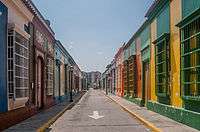
Culture in Maracaibo is very indigenous and unique, is recognized in every state and city in Venezuela, and is very influential with its gaitas, desserts, style, living, and customs. Most major houses of advertising in Venezuela acknowledge how opposite the culture of Maracaibo is from that of Caracas. Studies of both prove, for example, that Caracas' leading soft drink brand is Coke, while in Maracaibo it is Pepsi. This has made many brands create special localised advertising of their products (including several Pepsi commercials spoken by local celebrities).
Marabinos are extremely proud of their city, their culture, and all of Zulia. They usually claim that Venezuela wouldn't be the country it actually is without Zulia. Rivalry with inhabitants of other regions is common, specially with Gochos (people of the Trujillo, Mérida and Táchira state) and Caraqueños (people of the city of Caracas).
The Gaita is a style of Venezuelan folk music from Maracaibo. According to Joan Corominas, it may come from gaits, the Gothic word for "goat", which is the skin generally used for the membrane of the furro instrument. Other instruments used in gaita include maracas, cuatro, charrasca and tambora (Venezuelan drum). Song themes range from humorous and love songs to protest songs.The style became popular throughout Venezuela in the 1960s, and it fused with other styles such as salsa and merengue in the 1970s. Famous gaita groups include Maracaibo 15, Gran Coquivacoa, Barrio Obrero, Cardenales del Éxito, Koquimba, Melody Gaita, Guaco, Estrellas del Zulia, Saladillo, and many others.
Museums, cultural centers and theaters
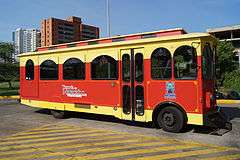
- Museo de Arte Contemporáneo del estado Zulia (MACZUL)
- Museo General Rafael Urdaneta
- Museo Municipal de Artes Gráficas "Balmiro León"
- Centro de Bellas Artes de Maracaibo
- Centro de Arte de Maracaibo "Lía Bermúdez"
- Teatro Baralt
Libraries
- Biblioteca Publica del Zulia
- Biblioteca Pública "Arturo Uslar Pietri"
- Biblioteca "Dr. Pedro Alciro Barboza de la Torre"
- Biblioteca Pública "Simón Palmar"
- Biblioteca Pública "Luís Guillermo Pineda Belloso" (De carácter público, bilingüe y circulante)
- Biblioteca Pública Especializada "Pedagógica"
- Biblioteca Pública Especializada "SEDINI"
Notable natives
- Teolindo Acosta - baseball player
- Gustavo Aguado - musician, singer and leader of Guaco, Venezuela's most influential music band
- Ricardo Aguirre - composer and singer
- Daniel Alvarado - singer and actor
- Wilson Álvarez - Major League Baseball left-handed pitcher
- Ernesto Aparicio - Major League Baseball baseball player, manager, and team owner
- Luis Aparicio - former shortstop in Major League Baseball and member of the Baseball Hall of Fame
- Pedro Aranguren- militar
- Eduardo Arcila Farías - journalist and historian
- Rafael Maria Baralt - diplomat, writer, philologist, historian, first Latin American to occupy a chair at the 'Real Academia Española'
- Huascar Barradas - flutist
- Rafael Belloso Chacín - physician
- Luis Barrera Linares - writer, academic, teacher of Universidad Simon Bolivar
- José Bracho - baseball pitcher
- Antonio Briñez - first manager to win a National Amateur Baseball championship to Venezuela
- María Calcaño - poet
- José Antonio Casanova - baseball player and manager of the Venezuelan team that won the gold medal in 1959 Panamerican Games
- Abel Castellano Jr. - jockey
- Javier Castellano- jockey Eclipse Award 2013, 2014, 2015, 2016. Hall of Fame
- Heberto Castro Pimentel - sport journalist
- Gustavo Chacín - Major League Baseball pitcher for the Toronto Blue Jays
- Gilberto Correa - TV host
- David Cubillan - basketball player, Marquette University
- Chiquinquirá Delgado - actress and TV host
- Adolfo D'Empaire- physician
- Francisco Jose Duarte - mathematician
- Xabier Elorriaga- actor
- Heraclio Fernández - pianist and composer
- Lupita Ferrer - actress
- Jacqueline Goldberg - poet
- Betulio González - boxer
- Carlos González - Major League Baseball outfielder for the Colorado Rockies
- Geremi González - Major League Baseball player for the Chicago Cubs, Tampa Bay Devil Rays, Boston Red Sox, New York Mets, and the Milwaukee Brewers
- Mariana González Parra - fencer
- Elio Gómez Grillo - criminologist
- Ulises Hadjis- singer-songwriter and multi instrumentalist
- Alejandro Hernández - Internet comedian
- Jonathan Herrera - second baseman for the Colorado Rockies
- Wilmer Herrison - painter
- Ender Inciarte - center fielder for the Atlanta Braves
- Ninibeth Leal - Miss Venezuela World 1991, Miss World 1991
- Sandy León - baseball player
- Carlos López Bustamante - journalist, known for his fierce opposition to the dictator Juan Vicente Gómez from the pages of Diario El Fonógrafo
- Eduardo López Bustamante - journalist, lawyer, and poet
- Teresa López Bustamante - journalist, founder of the Catholic Venezuelan newspaper La Columna (The Column)
- Eduardo López Rivas - editor, journalist, founder and director of the newspaper Diario El Fonógrafo and the magazine El Zulia ilustrado
- Tulio Enrique León - blind organist, composer, and arranger
- Sandy Leon- Major League Baseball catcher for the Boston Red Sox
- Jesús Enrique Lossada - journalist, lawyer, parliamentarian, President of the Universidad del Zulia, teacher, writer
- Julio Machado - Major League Baseball pitcher
- Domingo Luciani - physician
- Carlos Meyer Baldo - fighter pilot and the only Latin American member of the Red Baron's flying circus, awarded the Iron Cross during WW I[16]
- Domingo Marcucci - shipbuilder and shipowner in San Francisco, California
- Ernesto Mayz Vallenilla - philosopher, rector of Universidad Simon Bolivar
- Armando Molero - songwriter
- Carlos Molina Tamayo - navy militar
- Carmen Maria Montiel - Miss Venezuela 1984, Miss Universe 1984 2nd runner up
- Carlos Caridad-Montero - film producer
- Humberto Fernández Morán - research scientist, developed the diamond scalpel and founded "IVIC", the Venezuelan scientific research institute ("Instituto Venezolano de Investigaciones Cientificas") http://www.ivic.gob.ve
- Lila Morillo - actress and singer
- Francisco Ochoa - first President of the Universidad del Zulia
- Rougned Odor - second baseman for the Texas Rangers (baseball)
- Angel Francisco Parra - jockey
- Gastón Parra Luzardo- Economist president of PDVSA in 2002
- Nick Pocock - former cricketer, ex-captain of Hampshire County Cricket Club
- Eduardo Rahn - musician, conductor of Maracaibo Symphony Orchestra
- Carlos Ramírez MacGregor - journalist, politician and writer
- L. Rafael Reif - electrical engineer and the 17th President of the Massachusetts Institute of Technology
- Graciela Rincón Calcaño - poet
- Rafael Romero Sandrea - track and field athlete
- Daniel Sarcos - Telemundo TV host
- Havid Sanchez - musician, conductor of Maracaibo Symphony Orchestra
- Monica Spear - Miss Venezuela 2004, Miss Universe 2005 4th runner up
- Orlando Urdaneta - actor
- Rafael Urdaneta - hero of the Latin American war for independence
- Vivian Urdaneta - Miss Venezuela International 2000, Miss International 2000
- Patricia Van Dalen - painter
- Patricia Velásquez - actress and international top model
- Leonardo Villalobos - actor and television personality
Districts
| Maracaibo Districts | |
|---|---|
| Venancio Pulgar • Idelfonso Vázquez • Coquivacoa • Barrio 18 de Octubre • Juana de Ávila • El Naranjal • San Jacinto (La Marina) • Mara Norte • La Trinidad • Las Tarabas • La Estrella • Maracaibo I • Maracaibo II • Lago Mar Beach • Antonio Borjas Romero • San Isidro • Francisco Eugenio Bustamante • San Rafael • Ziruma • San Miguel • Luis Hurtado Higuera • Manuel Dagnino • Cristo de Aranza • Cecilio Acosta • Cacique Mara • El Amparo • Raúl Leoni • Caracciolo Parra Pérez • Los Olivos • Chiquinquirá • Santa Lucía • Santa Rosa • Bolívar • Bella Vista • Historic zone of Maracaibo • El Saladillo • Isla Dorada | |
International relations
Twin towns – Sister cities
Maracaibo is twinned with:[17]
|
Skyline

Notes
- 1 2 Archived November 14, 2009, at the Wayback Machine.
- 1 2 Archived November 14, 2009, at the Wayback Machine.
- ↑ Irama Iglesias. "Error". efemeridevenezolana.
- ↑ Das Imperium der Welser Archived 2012-04-22 at the Wayback Machine.
- ↑ Harry Morgan's Way, (AlisonPress, 1977), Dudley Pope, ISBN 978-1842324820
- ↑ Caribbean, James A.Michener, Guild Publishing, 1989, ASIN: B00EFKMICY
- ↑ "Maritieme kalender 1908". Hetscheepvaartmuseum.nl. Retrieved 2013-07-01.
- ↑ David M. Cheney. "Maracaibo (Archdiocese) [Catholic-Hierarchy]". catholic-hierarchy.org.
- ↑ "Religion: Si to a Demanding Friend". TIME.com. 11 February 1985.
- ↑ David M. Cheney. "Maracaibo (Archdiocese) [Catholic-Hierarchy]". catholic-hierarchy.org.
- ↑ "Huntington's disease" The Lancet 369 (9557): 218–28 [221]. doi:10.1016/S0140-6736(07)60111-1. PMID 17240289
- ↑ "Estadísticos Básicos Temperaturas y Humedades Relativas Máximas y Mínimas Medias" (PDF). INAMEH (in Spanish). Instituto Nacional de Meteorología e Hidrología. Archived from the original (PDF) on 15 June 2013. Retrieved 15 May 2014.
- ↑ "Estadísticos Básicos Temperaturas y Humedades Relativas Medias" (PDF). INAMEH (in Spanish). Instituto Nacional de Meteorología e Hidrología. Archived from the original (PDF) on 15 June 2013. Retrieved 15 May 2014.
- ↑ "Maracaibo Climate Normals 1961-1990". National Oceanic and Atmospheric Administration. Retrieved 15 May 2014.
- ↑ "World Weather Information Service - Maracaibo". World Meteorological Organization. Retrieved 15 May 2014.
- ↑ "jastaboelcke.de". jastaboelcke.de.
- ↑ Sister Cities designated by Sister Cities International, Inc. (SCI) Archived February 17, 2008, at the Wayback Machine.. Retrieved June 8, 2006.
- ↑ Frohmader, Andrea. "Bremen - Referat 32 Städtepartnerschaften / Internationale Beziehungen" [Bremen - Unit 32 Twinning / International Relations]. Das Rathaus Bremen Senatskanzlei [Bremen City Hall - Senate Chancellery] (in German). Archived from the original on 2011-07-18. Retrieved 2013-08-09.
References
de Pons, François (1806), A Voyage to the Eastern Part of Terra Firma, or the Spanish Main, in South-America, during the years 1801, 1802, 1803, and 1804, New York City: I. Riley and Company
External links
| Wikimedia Commons has media related to Maracaibo. |

- (in Spanish) Panorama Digital -Largest Maracaibo based newspaper
- (in Spanish) La Verdad - Maracaibo-based newspaper.

